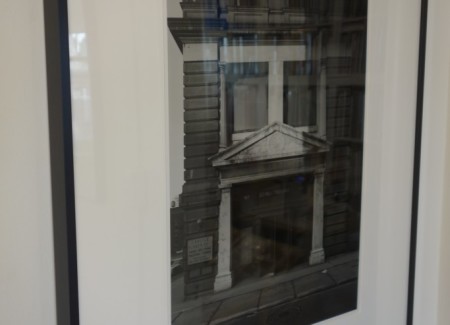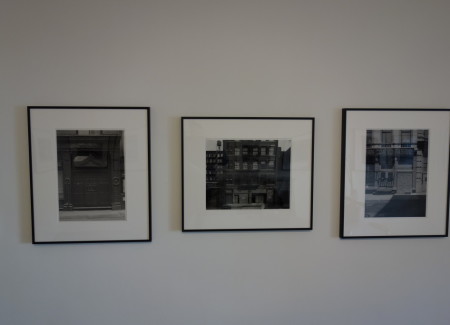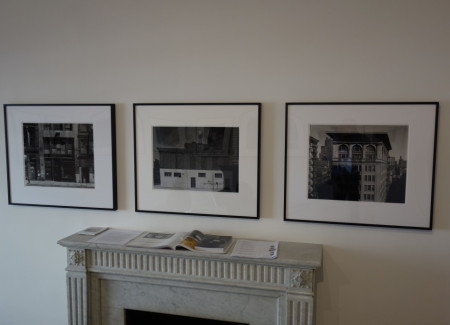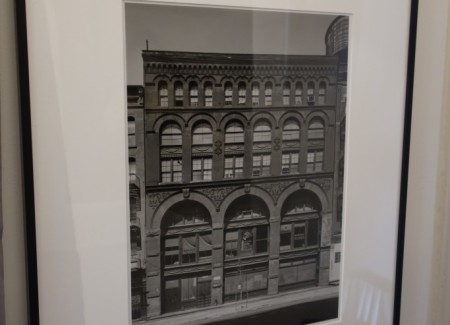JTF (just the facts): A total of 21 black and white photographs, framed in black and matted, and hung against white walls in the single room gallery space and the entry hallway. All of the works are vintage ferrotyped gelatin silver prints, made between 1975 and 1977. Each of the prints is sized 20×16 (or reverse), and no edition information was provided. (Installation shots below.)
Comments/Context: While basic mastery of craft has generally been a requirement for most serious photographers since the birth of the medium, something special happens when photographic meticulousness is taken to a radical extreme. With each succeeding layer of structure and rigor applied to the process of making photographs, it’s as if a kind of otherworldly purity is drawn out, this visual and conceptual sharpness emerging from a brand of intense pressure not unlike the one that turns carbon into diamonds. When photography becomes this painstakingly controlled, it feels both entirely lacking in style, as though all emotion and humanity has been drained away, and surprisingly mannered, like the photographer has been executing the fastidious steps of an invisible dance. It’s almost as if an elusive, heightened form of elemental seeing only emerges when this conscious stripping away goes far enough.
Bevan Davies’ mid-1970s images of the buildings of Lower Manhattan revel in this alchemy of purposeful clarity. Taken in the early morning when the streets were empty of activity and executed with various large format cameras, his portraits of overlooked doorways, buildings, and architectural details shimmer with deafeningly crisp silence, the lusciousness of their subtle tonal variations muted by the strictness of the surrounding geometries.
If this kind of reductionist approach sounds familiar, it should. We can travel all the way back to the mid-1850s to find Edouard Baldus applying the same kinds of squared-off, frontal techniques to the ornate architectural constructions of Paris, and we can jump forward to the 1960s and 1970s (effectively concurrent with Davies) to track Bernd and Hilla Becher, Lewis Baltz, and many of the other photographers categorized under the umbrella of the New Topographics looking with astonishing intensity at the more modern structures and forms of water towers, coal mines, suburban office parks, and sprawling housing developments. In each case, across more than a century of artistic effort, the clarity of vision being applied to the subjects dominates the compositions, creating photographs that distill the architecture down to its bare-bones essence, where its truths are encouraged to come forth.
At his narrowest, Davies takes us in close to the surroundings of a single door or entrance, where we steep in the details of the fluting and capitals of the columns, the linear arrangements of moldings, and the rectangular positioning of glass panels and flanking windows. Each image is a tight exercise in controlled framing, where horizontals and verticals are brought into tenuous equilibrium, as if managed by an invisible grid.
Davies then takes a handful of steps back and takes in a selection of adjacent doorways along the same patch of quiet sidewalk. These pictures add a layer of architectural dissonance to his compositions, where competing geometries from side-by-side motifs struggle to find balance. Cornices elbow nearby striations, doorways of different sizes and shapes jostle with each other, and fire escapes slash across facades and cast shadows the interrupt the lines; even when Davies opts for views that linger in the same shades of grey, these pictures deliver more complex visual harmonies than his single doorways.
And a few of Davies’ images cross the street and take in the entire bulk of a multi-story building, allowing the repetitive patterns of windows and the bolder contrasts of dark and light to take over. While a few of these edge toward a Berenice Abbott-style drama, where sidelong angles create a kind of urban romance, most search for a feeling of completeness, where a single building shows us everything it has to offer and we can celebrate its unadorned moments of energy and grace without distraction.
When Davies’ photographs find the severe magic of well-seen simplicity, they jump from being documents of overlooked architecture from decades gone by to something more powerfully universal – it’s as if they pass through some kind of force field and start to tingle with contemporary resonance. Like the best of Harry Callahan and Aaron Siskind’s images of facades from the 1940s and 1950s, their composition pinpoints something timeless, like the elemental rhythms that pulse through our cities, only visible to those who listen (and look) with the utmost of care.
Collector’s POV: The prints in this show are priced at $7500 each. Davies’ work has little secondary market history, so gallery retail remains the best option for those collectors interested in following up.














One of the more interesting, and informed, reviews of my photographs.
Bevan Davies
When I saw the photographs of Bevan Davies at http://www.josephbellows.com/artists/bevan-davies/ there was an experience of a great photographer and the silence of photography, its story and his photographs only circulated with control.
In the modern psychology, he physically died, however, he passed with love. As you know, love can not be seen. It hits you like a Mac Truck when it is gone and we have never synthesized the original.